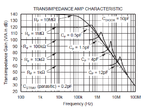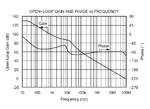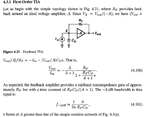coxstreet
Junior Member level 3
Hi guys, I am reading the TIA product (TI OPA380) data sheet but confused about frequency response of the opamp and its TIA, which are all attached below.
I don't get why the TIA has so large -3db bandwidth. Take Rf= 1k ohms as an example. Ideally, Aclose_loop = 60dB and -3dB bandwidth of TIA showed is 10M Hz. But mathmatically, Acl= Ao/(1+Ao*f) and f=1/Rf. So Acl = Rf/(Rf/Ao+1) and this means when Ao is much larger than Rf, Rf/Ao + 1 ---> 1 and then Acl = Rf roughly. But when the Ao drops with the increasing frequency, the Acl will drop. I guess this is why the -3dB happen.
But in this data sheet, before f<100K Hz, Ao > 60dB=Rf. So before this, the DC gain of TIA still doesnot drop I understand. But after f=100k Hz, Ao begins to drop so I think Acl, the TIA gain, needs to drop.
So my question is how to explain the -3dB bandwidth is so large when compared with Ao. Thanks!
I don't get why the TIA has so large -3db bandwidth. Take Rf= 1k ohms as an example. Ideally, Aclose_loop = 60dB and -3dB bandwidth of TIA showed is 10M Hz. But mathmatically, Acl= Ao/(1+Ao*f) and f=1/Rf. So Acl = Rf/(Rf/Ao+1) and this means when Ao is much larger than Rf, Rf/Ao + 1 ---> 1 and then Acl = Rf roughly. But when the Ao drops with the increasing frequency, the Acl will drop. I guess this is why the -3dB happen.
But in this data sheet, before f<100K Hz, Ao > 60dB=Rf. So before this, the DC gain of TIA still doesnot drop I understand. But after f=100k Hz, Ao begins to drop so I think Acl, the TIA gain, needs to drop.
So my question is how to explain the -3dB bandwidth is so large when compared with Ao. Thanks!



